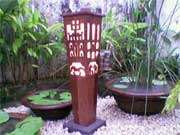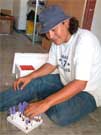By ELIZABETH PISANI
998 words
14 February 1996
<
Asia Times
English
(c) 1996 Chamber World Network International Ltd
Le Van Danh wanted to be Robin Hood. But instead of making life more secure for Vietnam's poor rice farmers, he finds himself making life more comfortable for the golf-playing class.
In the back room of a grease-stained car workshop, Danh recalls visiting his rice-farming uncle during the autumn harvest of 1991. "He took me out to his fields and there was the rice, all dry, empty husks, all eaten by pests. It was his whole year's work, and he just had to burn it off. He would spend the next two years in debt, just to feed his family. I wanted to cry."
Danh resolved to do something to help Vietnam's farmers in their war against rice brown plant hopper, stem borer and the myriad other insects which eat away at crops and livelihoods.
He began with the principle that insects are attracted to light. Concentrating them in one place was the easy part - he still had to come up with a way of trapping them. "Every 10 days or so, I would wake up at midnight with a new idea and come down to the workshop to try it out."
Danh built motors, fans, vacuums, all manner of contraptions in an effort to beat the bugs. After a couple of months, he had run out of cash.
"I took my wife's jewelry, to sell it. She was livid, but I did it anyway," he said, looking sheepishly at his smiling wife, who, wreathed in gold chains, seems to have recovered.
He invested the money in more equipment, and finally produced his masterpiece. At roughly two meters high, it looks like a gaping whale's mouth, which sucks its food into a giant windsock of a body. Four green fluorescent lights surround the contraption at a distance of about 300 meters. The whole affair is powered by a small diesel generator.
The lights attract the insects into a central area, where they are drawn by a fan through the mouth into the windsock.
When Danh saw a television report of a rice brown plant hopper infestation in Cu Chi, close to Ho Chi Minh City, he set out to test his invention.
"When we switched on the lights, the insects were swarming thick as a cloud. In two nights we had collected 15 kilos of insects," he said.
His wife puts on a video of that first test and there they are, piles and piles of bugs, caught in the giant sock.
Danh is by no means the first person to have thought of using lights to trap bugs, and some believe his invention is doomed to fail for two reasons.
First, the pests most common in these parts are those that live near the surface of the rice paddy or inside the rice stem itself. They are therefore less likely to be caught by the machine.
Second, the new approach to pest control is to manage the ratio of bugs in a field, so that good bugs, or those that eat other bugs, are able to keep down the population of the bugs that eat the rice. Danh's invention is indiscriminate: It sucks in all flying bugs and may in fact upset the balance which nature tries to maintain between bugs, good and bad. In turn, the device may give those that damage crops the upper hand.
Because no light trap can be 100 percent efficient in catching bugs, Danh's device may make matters worse if it is used consistently in the same area - insects will be attracted into certain fields by the lights and those that escape the vacuum may settle there for their evening meal and possibly lay their eggs as well.
Danh waves away these concerns, saying his tests show at least nine out of 10 insects are collected by his powerful machine - a claim that raises eyebrows among crop protection specialists.
For Danh, the problem is quite the reverse. Farmers do not want to invest in his machine because it is too efficient.
"Vietnamese farmers still have very selfish ideas," he said. Although it is impossible to determine exactly the range of his machine, he thinks it is around 10,000 square meters. "Anyway, it is certainly more than one farmer's land."
So, said the 46-year-old car mechanic, no one family wanted to put up the six million dong (US$545) a machine and diesel generator would cost.
"They don't want to see another farmer benefit from their investment."
Danh's solution is to sell the machine to those who do want it. His client of choice is Thu Duc golf course, the playground of those citizens of Ho Chi Minh City wealthy enough to pay membership fees of US$10,000.
The manager of Thu Duc was put in touch with Danh after a member of Vietnamese Prime Minister Vo Van Kiet's golfing party familiar with the inventor's work heard him complaining about insect control on the course.
Entomologists said the machine was likely to be more useful on the golf course - where the goal was not to balance different bug types but to have no bugs at all - than in the more complex ecosystem of the rice field.
Danh has made a deluxe model for Thu Duc, replacing the ragged army-surplus parachute of the insect collecting bag with flashy orange and white striped silk bound in purple. And he has priced it to match - US$1650 a shot.
With a contract for 10 machines now under his belt, he hopes not to buckle completely to the pressures of the market economy. "Money is necessary for everyone," said Danh.
"But if Vietnam could produce these cheaply to help other poor rice-farming countries, I would be very happy," the high-school dropout. added.
Copyright 1996 Asia Times.
(c) 1996 Chamber World Network International Ltd.




